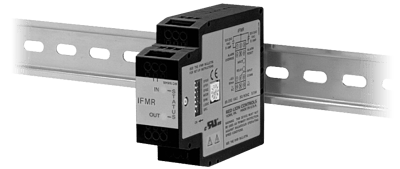Model IFMR DIN Rail Speed Switch
Brand: Red Lion ControlsThe Model IFMR accepts a frequency input, and controls a single relay (SPDT) based on the value of the input frequency. The Trip frequency can be set to any value from 0.1 Hz to 25 kHz.
The IFMR can be set to trip on overspeed, or underspeed (including zero speed). Offset and hysteresis values can be incorporated into the trip setting to eliminate output chatter.
LED indicators for both the Input signal and the Relay status are provided.
Two separate input connections for external push-buttons are also provided. One external input overrides the trip detection function, and holds the relay in the release state as long as the input is pulled to common. The other external input clears a latched trip condition when pulled to common.
The IFMR utilizes a seven position DIP switch, a rotary switch, a pushbutton and two indication LEDs to accomplish input circuit configuration, operational parameter set-up, input signal, and relay status indication.
The input circuitry is DIP switch selectable for a variety of sources.
The indication LEDs are used during normal operation to display the input signal and relay status of the IFMR. These LEDs are also used to provide visual feedback to the user of the current parameter settings during parameter set-up.
Features- Simple on-line trip frequency setting (using actual input signal or frequency generator)
- User settable trip frequency from 0.1 Hz to 25 kHz
- Over-speed, under speed and zero-speed detection
- Relay latching, alarm override and alarm reset functions
- Programmable input circuits accepts outputs from a variety of sensors
- Hysteresis and offset functions available
- 85-250 Vac and 9-32 Vdc versions available
- Input and relay status indication LED's
Specifications
Brand
Accuracy
- ± 0.1 % of the Trip Frequency Setting
Approvals & Certifications
- CE
- CSA C22.2 No. 14 (C,US)
- EMC Emissions: EN 50081-2, Immunity: EN 50082-2: EN 61000-4-2, 3, 4, 6, 8
- IEC 61010-1, EN 61010-1
- UL File E137808, 508
Current
- Power Up Current: 600 mA for 50 ms, max.
Electrical Connectors
- Screw Typical Terminal Block
Electrical Rating
- 1/8 hp at 120 Vac (Inductive Load)
- 5 A at 120/240 Vac (Resistive Load)
- 5 A at 28 Vdc - Resistive Load
Enclosure, Body Material
- Plastic
Frequency
- Operating Frequency: 0 to 25 kHz
Humidity
- 85 % RH, Non-Condensing from 0° to 50° C
Indication
- LED
Input
- Active Low (VIL = 0.5 V, Max.
- High Bias Input Trigger Level IH: 3 V
- High Bias Input Trigger Level IL: 2.5 V
- Low Bias Input Trigger Level IH: 0.75 V
- Low Bias Input Trigger Level IL: 0.25 V
Input Impedance
- 33 kΩ min. with the Sink & Source DIP Switches in the OFF Positions
Input Signal
- ± 90 V
- 2.75 mA - Max.
Isolation
- Breakdown Voltage (Dielectric Withstand): 2,200 V between Power & Input, & Power & Output
- Breakdown Voltage (Dielectric Withstand): 500 V between Input & Output for 1 Minute
Mounting
- Standard DIN Style Mounting Rails, Including Top Hat Profile Rail According to EN 50 022 - 35 x 7.5 & 35 x 15, & G Profile Rail According to EN 50035-G32
Operating Temperature
- 0° to 50° C (32° to 122° F)
Operating Time
- Relay Contact Output: 5 ms Nominal
Power
- 85-250 Vac, 48 to 62 Hz, 5.5 VA
- 9-32 Vdc, 2 W
- Sensor Power: (AC Version Only) +12 Vdc ± 25 % at 60 mA - Max.
Release Time
- Relay Contact Output: 3 ms Nominal
Resistance
- Current Sinking: Internal 3.9 kΩ Pull-Up Resistor for Sensors with Current Sinking Output, max.
- Current Sourcing: Internal 1 kΩ Pull-Down Resistor for Sensors with Current Sourcing Output, max.
Response Time
- Minimum 5 ms + 1 Period to 10 seconds + 1 Period in Ten Steps (Excluding Relay Operate Time)
Shock
- 30 G (10 G Relay), 11 ms in 3 Directions According to IEC 68-2-27
Storage Temperature
- -40° to 80° C (-40° to 176° F)
Switch Type
- DIP Switches
- Relay: Form C, SPDT
Vibration
- 2 G at 5 to 150 Hz in X, Y, Z Direction for 1.5 Hours According to IEC 68-2-6
